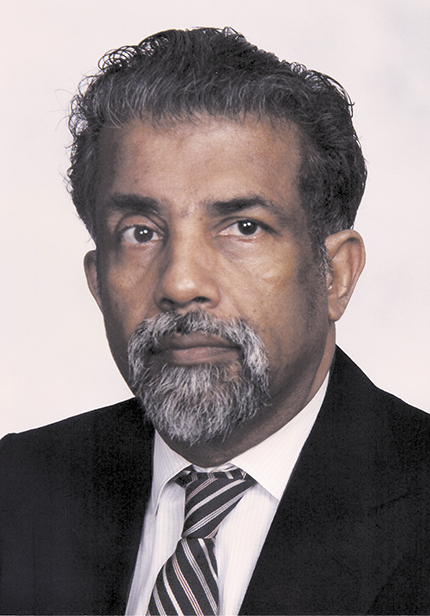Ennackal Chandy George Sudarshan
DOI: 10.1063/PT.3.4190
Ennackal Chandy George Sudarshan, a titan of 20th-century theoretical physics who made seminal contributions to several fields, passed away in Austin, Texas, on 13 May 2018. His vector−axial vector (V−A) theory of the weak interaction and optical equivalence theorem sparked revolutions in high-energy physics and quantum optics.

Ennackal Chandy George Sudarshan

George was born on 16 September 1931 in Pallam, India. After completing a BSc from Madras Christian College in 1951 and an MA from the University of Madras in 1952, he joined the Tata Institute of Fundamental Research in Mumbai, where he worked on cosmic-ray showers with Homi Bhabha. He also became the scribe for quantum mechanics lecturer Paul Dirac and took excellent notes for him. He was recruited by Robert Marshak of the University of Rochester as a doctoral student and within two years formulated the V−A theory of the weak interaction.
After receiving his PhD in 1958, George did a brief stint as Julian Schwinger’s research fellow at Harvard University before returning to Rochester, where he developed the optical equivalence theorem. He then worked at the University of Bern and Syracuse University before joining the University of Texas at Austin in 1969. He also served as the director of the Institute of Mathematical Sciences in Chennai, India, from 1984 to 1991.
In the mid 1950s, the discovery of parity violation demanded a consistent theory of the weak force. George’s comprehensive analysis of all weak-decay data convinced him that if there was a universal Fermi interaction, with parity violation built in, it had to include the axial-vector interaction, since charged pion decay could be viewed as beta decay of a nucleus with zero atomic mass. He came to the far-reaching conclusion that a V−A structure of weak interaction could explain all but four crucial experimental results. When researchers repeated the experiments, they yielded the results his theory predicted. That discovery was crucial to the later unification of the weak and electromagnetic interactions by Steven Weinberg, Abdus Salam, and Sheldon Glashow.
George’s work with Marshak, Susumu Okubo, Weinberg, and others on weak interactions led to the successful application of final-state interactions to the decay of lambda hyperons and contained the general method for solving singular integral equations. With Marshak and Okubo, George discovered the general theorem on sum rules with symmetry breaking and the first application of symmetry groups to obtain sum rules. George also helped introduce other applications of group-theoretic methods that led to the relations between the magnetic moments of sigma particles and the transition moments of sigma and lambda particles.
The classical and semiclassical theories of optical field coherence had been developed by Emil Wolf and Leonard Mandel during the 1950s and 1960s. Roy Glauber proposed in February 1963 a quantum model for optical coherence, which involved normally ordered quantum correlation functions.
George’s diagonal representation of the density operator in terms of coherent states appeared in April 1963. He showed that the coherent states’ overcompleteness could be used to represent every density operator in the diagonal form and that a general quantum correlation function could be computed in a simple way once it was re-expressed in normally ordered form. Known as the optical equivalence theorem, George’s result showed how quantum optical correlations could be expressed in terms of a quasi-probability density and in a manner analogous to classical correlations. The novel and crucial feature was that the quasi-probability density could take on negative values, which is the signature of an optical field’s quantum nature, as seen in the anti-Hanbury Brown–Twiss effect and photon antibunching.
With Baidyanath Misra, George predicted the quantum Zeno effect, so named because the decay of an unstable quantum state, measured sufficiently frequently, is hindered. His work with Piravonu Mathews and Jayaseetha Rau generalizing the classical stochastic processes to the quantum domain was the precursor to his later work on the development of quantum correlations between parts of a large system. That led to the theory of stochastic semigroups from which emerged the Gorini-Kossakowski-Sudarshan equation that forms the basis for the study of large open systems. George provided a nonrelativistic proof of the spin-statistics theorem by imposing appropriate restrictions on the kinematic part of the Lagrangian of a field theory derivable from a Weiss–Schwinger type of principle of least action.
One of George’s most famous papers, written with Vijay Deshpande and Olexa-Myron Bilaniuk, was on faster-than-light particles, later named tachyons, which caught the imagination of a generation of physicists and science fiction writers. George was always ready to branch out into new fields, and as a natural progression of his studies on open systems and dynamical maps, he was analyzing problems in quantum tomography and quantum computing during his last years.
George received the first physics prize from the World Academy of Sciences in 1985. Among his other awards were India’s second-highest civilian award, the Padma Vibhushan, in 2007 and the Dirac Medal from the Abdus Salam International Centre for Theoretical Physics in 2010.
Gentle, witty, humorous, and kind, George touched everyone with his generosity and warmth.
More about the Authors
M. K. Balasubramanya. Texas A&M University–San Antonio.
M. D. Srinivas. Centre for Policy Studies, Chennai, India.
